Know when to travel, the best Thailand beaches and food tips for your vacation
Travel Thailand
Thailand has always been a backpacker’s paradise and has now evolved into one of the world’s most popular tourist haven for adventurers, digital nomads, honeymooners, hikers and more. From lush rainforests and miles of unspoiled coastline to floating markets, historic temples, and the bustling city of Bangkok, there’s lots to see and do in the Land of Smiles.
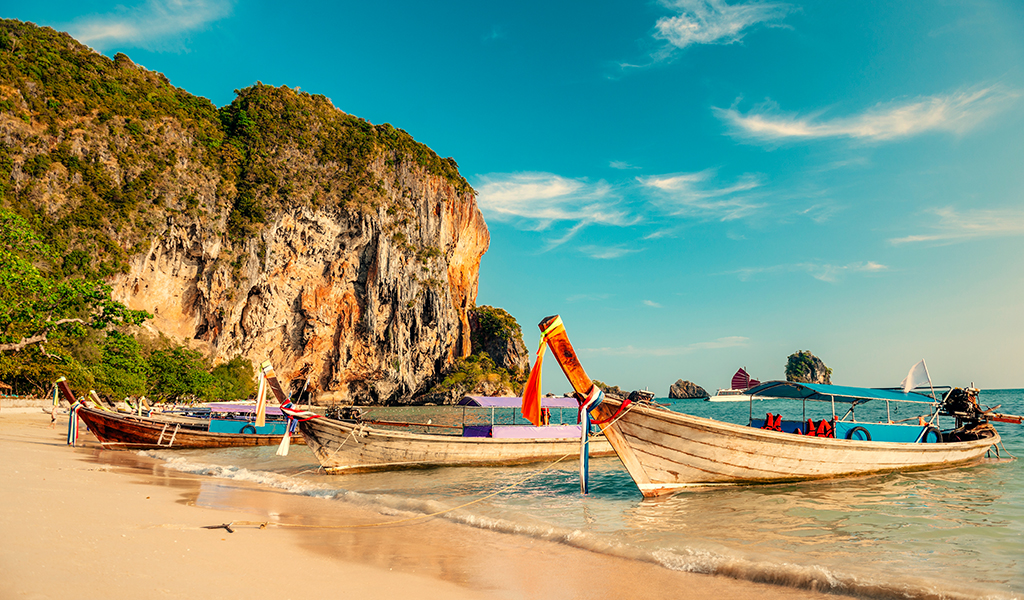
Geography and Currency
Thailand is located in southeast Asia and shares borders with four countries, including Burma, Cambodia, Malaysia, and Lao People’s Democratic Republic. Its capital city is Bangkok.
The Thai people use Baht (THB) as their currency. One of the most popular tourist destinations in the world, the country welcomed more than 34 million visitors in 2018, and those numbers are only predicted to grow in 2019.
No wonder – when you’re nicknamed the ‘Land of Smiles’, you’re bound to attract tens of millions.
Thailand is an incredibly budget-friendly destination – your Baht gets you a lot here! We’ll give you some tips on how to save on activities, places to stay, transportation, food and more.
Travel between November and April; avoid monsoon season
Your dream vacation in Thailand probably depends a lot on the weather; you’ll want to relax on idyllic beaches, shop the floating market, explore temples and spend lots of time outdoors. Travel + Leisure says the best time to visit is between the end of November and the end of April. Rainy season usually runs from July through October, but it’s possible to see a major storm as early as May.
That said, there are pluses to booking between December and the end of February; for beach goers and island explorers, the air will be less humid, you won’t get scorched by the sun, and you’ll enjoy the light evening breeze.
Tip: Avoid planning your trip during monsoon season, between July and the end of October. – Travel + Leisure.

Stick to local neighbourhoods for accommodations
When it comes to finding a place to stay, when and where you travel matter. TripSavvy has some good tips for the budget-conscious:
<blockquote"Chiang Mai and destinations in Northern Thailand such as Pai are relatively less expensive than Bangkok and the islands. If you're on a shoestring budget, you'll get more for your money in Chiang Mai and northern destinations in Thailand."
You can also scope out local neighbourhoods far away from tourist spots. Khao San Road and Soi Rambuttri are in Bangkok’s Banglamphu area. Though some “weirdness” still exists, many of Khao San Road’s surrounding streets are now lined with chic, boutique guesthouses.
Using smart budget travel techniques, TripSavvy says backpackers can travel Thailand for $25 to $30 US (that’s about $32 to $40 CDN) per day.
Looking to stay in Bangkok? The Pinay Solo Backpacker suggests booking your room early at one of the budget hotels in the city’s financial district. In Silom, you’ll find the Lub d Bangkok Silom Hostel, HQ Hostel, and Hostel Na Nara, while Tara Place is in Khao San Road. You can also check out Lumphini Park, which is packed with affordable rooms.
Of course, although accommodations will cost more in Bangkok, you’ll have more access to transportation and other amenities, notes Helen, who visited Thailand in 2016:
<blockquote"We started in Bangkok and it's an amazing city. I would say it's important to research the area you're staying in as if you move too far out of the city you can be pretty cut off and be reliant on taxis," she said, adding, "The street food is brilliant. Booking a hotel with a pool is a big one as it's so hot that it can be uncomfortable. The Grand Palace is amazing and worth a visit.”
Accommodation budgets vary – travel budget website Budget Your Trip says Canadians can expect to pay about $42 per person per night for a hotel or hostel.
Airbnb is a hot-button issue in Thailand
In January 2018, a court ruled that owners of two condominiums violated the Hotels Act of 2004 by renting their rooms out daily and weekly. It remains to be seen what impact this will have on the popular vacation/home rental website. Regardless, if you want to check out Airbnb spaces for rent, you can do so on their site.

Safety, Visa and passport info
Check risk levels and stay safe
If you choose to visit Thailand, stay safe: As of January 2019, the Canadian government published a travel advisory on its website, saying Canadians should use a high degree of caution in Thailand because of ongoing political tensions and sporadic demonstrations in Bangkok and around the country. Check the current risk level for any destination, read about safety and security measures you should take and find other useful information at travel.gc.ca.
Have a valid passport
Your passport must be valid for at least 6 months after you leave Thailand. Also, make sure it’s in good condition – Thai immigration is strict on the physical condition of passports and if they find defects, you could be refused entry.
Visas
Tourist visas are not required for stays of up to 30 days. If you’re traveling with a regular Canadian passport, you can obtain a 30-day visa upon arrival. With a multiple entry tourist visa, you can stay for up to 60 days. The visa is valid for 6 months and you must get it before traveling.
Entry stamp
Get an entry stamp from an immigration officer when you enter Thailand.

Hop on a train, busm or tuk tuk
Airports
Flying into Thailand, you’ll land in one of eight international airports:
- Suvarnabhumi International Airport (the new Bangkok International Airport)
- Don Mueang International Airport
- Chiang Mai International Airport
- Phuket International Airport
- Hat Yai International Airport
- Krabi International Airport
- Samui International Airport
TripZilla, a southeast Asian online travel magazine, has a comprehensive guide to the busiest airports in Thailand – check it out for information on airport locations, terminals, transportation and more.
Transportation
There’s no shortage of ways to get from point A to point B in Thailand, from hopping on a train, tuk tuk, or rickshaw to hailing a taxi or even jumping on a boat .
If you’re looking for the cheapest way to travel long distances and are not in a rush, Travelhappy.info recommends taking the train. An overnight third class train from Bangkok to Ubon Ratchathani on the border of Laos (a 12-hour trip) cost him only 205 THB ($6.77 US, or $8.90 CDN). Riding from Bangkok to Chiang Mai will cost you 271 THB ($8.94 US, or $11.75 CDN).
Tuk tuks are a well-known form of transport in Thailand and can be found in most parts of the country. The small, three-wheel vehicles are a good option if you’re going door-to-door. Although a ride isn’t the cheapest, this is an iconic experience to try, Culture Trip notes in its helpful guide to navigating transport in Thailand.
The country also has an extensive bus network, minivans (always take the local ones to save time and money), songthaews (a cheap, cheerful bus for traveling short distances locally), skylabs (which look like motorbikes from the front), samlors (motorbikes with sidecars), rickshaws, taxis, motorbike taxis, rental vehicles, ferries and boats, and finally, domestic flights.
There are a number of local city guides and ridesharing apps, too: from Bangkok MRT app to All Thai Taxi , NaviGo, and more.

Head to Bangkok for authentic Thai dishes
Looking for an authentic Thai experience? Head to Bangkok, where you can find delicious street food straight out of roadside push-carts or hidden among the maze of Bangkok night bazaars, says food and travel blogger Seth Lu. From Thai Wanton Mee (Ba Mee), a noodles-and-pork dish, to the freshest raw oysters (Hoi Nang Rom Song Kreung) you’ll find, there’s a good chance you’ll find a new favourite.
You can also eat ‘Thai style’, which means you order several dishes and share with everyone in your group (be prepared to chow down on a lot of food!), notes Tasty Thailand <https://tastythailand.com/how-to-eat-cheaply-in-bangkok-thailand-eat-like-a-thai-and-have-delicious-food/. Just like in Canada, there are also food courts in shopping malls or areas here, and you can easily get a typical Thai meal for two for $5 (about $6.57 CDN).
Tip: Keep your food expenses down by avoiding western restaurants, the more high-society Thai restaurants, and hotels. – Tasty Thailand
Explore parks, beaches, markets, and temples
Explore Prasat Hin Phimai (Phimai Historical Park)
In northeastern Thailand, Prasat Hin Phimai holds one of Thailand’s finest ancient Khmer temple ruins.
Take the trip to escape the crowds and you’ll be rewarded – this UNESCO World Heritage Site is worth the travel time, but beware: “Getting here involved several hours of road travel with multiple transfers,” says travel blog I Wander.
Relax on Koh Lanta’s beaches
Koh Lanta is a beautiful Thai island – ideal for holiday makers and digital nomads, notes Never Ending Voyage, a blog about travel tips from a digital nomad couple. Zip around on a moped or bicycle, and head to Long Beach, where golden sand, pine trees and swim-worthy, clear blue water await.
We also travelled to Koh Sumai and Koh Lanta. Koh Lanta is accessible via Krabi and is a trek but very much worth it. We wished we stayed on that side of Thailand and explored other islands instead. Koh Lanta is very much untouched and really beautiful and special. Koh Samai is nice but more touristy. I would say flying to Koh Samai is the only way as the boat and bus take much longer than advertised as we found out. We spent 17 hours on a bus with breaks and it was tough. – Helen

Wat Phra That Doi Suthep
Wat Phra That Doi Suthep is one of Chiang Mai’s most famous wats (temples). Overlooking the old city, it comprises many intricate and important statues, along with a golden Buddha statue, says travel blog Photo Katha’s guide to temples in Thailand.
If you’re ready to see some lush tropical islands, sign up for a tour and hop in a speedboat or longtail to visit secluded beaches, snorkel and potentially even see monkeys and other wildlife. This was on NOMADasaurus’ list of 10 of the best things to do in Ao Nang, Thailand.
Damnoen Saduak Floating Market
Thailand’s most popular floating market is located in Ratchaburi’s Damnoen Saduak district. Arrange a trip to Damnoen Saduak Floating Market or rent a longtail boat from the village to the market, which features local vendors selling art, cheap and delicious Thai food (for 25 to 50 Baht), and more. Say Sawasdee Ka, or Good Morning, and you’ll probably get a smile, mentions Lady Anne, a Filipino expat blogger who wrote about the market over at Lady and Her Sweet Escapes.
Tip: You will need to wear something on your shoulders and to the knees to any religious location in Thailand or you won’t be allow in.” – Helen
Thailand is a perfect place to visit if you’re looking to immerse yourself in local culture, relax on clean, picturesque sandy beaches, explore nature, indulge your taste buds in authentic Thai dishes, and much more. You can absolutely travel the Land of Smiles on a budget – if you stay in local neighbourhoods, make use of the public transportation system and various ridesharing apps, and hunt down some deliciously cheap street food while on adventure in Bangkok.
Are you travelling to Thailand for the first time? Returning to a favourite destination? What are your best tips when it comes to saving for vacations? We’d love to hear what you’ve planned, or any trips we missed! Share your story in the comments and tell us what destinations are on your wish list. Our team love saving for holidays and we hope to inspire our members with exciting suggestions to spend your Caddle money.
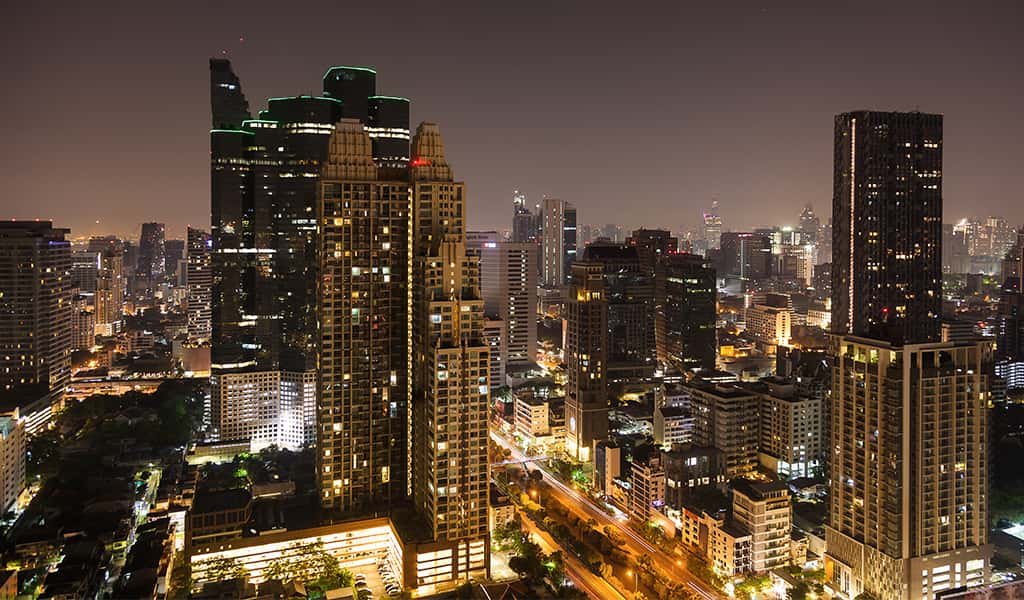
Learn more about traveling on a budget in Thailand
Backpacking Thailand travel guide for 2019 – Nomadic Matt
Thailand travel tips: Options for accommodation and Transportation – Tortuga Backpacks Blog
Erawan National Park (Erawan waterfall) in 2019
3 incredible temples you must visit whilst in Kanchanaburi, Thailand
Chicago things to do and where to stay
Travel Chicago
Before you even hit downtown, with its iconic architecture, refreshing green space and the Chicago River that sprawls through the city’s centre, you’ll start to imagine sinking your teeth into a deep dish pizza, a hot dog loaded with all the fixins, or maybe some delicious BBQ pork.
Whatever you’re craving, Chicago probably has it, from international cuisine and comfort food to satisfy every palette to eye-popping sites like the sprawling lakefront, live theatre scene, family entertainment, parks and shopping galore. Of course, there’s also the famous Wrigley Field, where you can spend an afternoon taking in a game.
Luckily, exploring Chicago on a budget is very doable – if you know which expenses are worth it, where to grab cheap eats and discounts, and how to use the robust public transit system to get around.

Geography
Chicago sits on the southwest shore of Lake Michigan in the state of Illinois.
Many think the nickname “Windy City” refers to the frigid breezes that blow in off the lake to sweep through the city’s streets, but there are also references that it had a double meaning and also functioned as a metaphorical jab to supposedly boastful citizens.
Visit Chicago during spring or fall for comfort and affordability
For the most affordable accommodations and comfortable temperatures, Passion Passport suggests booking your trip during its shoulder seasons: April, May, September, or October. If you’re okay with cold temps, try early or mid-December – holiday festivities are on, hotel prices more reasonable and the glut of tourists has left.
Bonus: Airfare drops in October and November as well. Watch for cheap flights and book your plane ticket about two months before your visit.
Stay at a hostel or rent an Airbnb
If you’re going to spend most of your time discovering the city, why throw down for an expensive hotel room? You have options when it comes to affordable places to stay during your visit, including the eco-friendly HI Chicago, The J. Ira and Nicki Harris Family Hostel mentioned by Little Things Travel. There, you’ll pay $30 a night and score free amenities like wi-fi, breakfast, sheets, towels and guided tours of the city.
You can also go the Airbnb route and stay in a beautiful apartment or loft – lots of beautiful spaces are available for between $50 to $80 CDN per night.
Check out TimeOut’s guide to amazing Airbnb Chicago homes you can rent.

Visa and passport info
Make sure you have your Canadian passport or a valid NEXUS card if you’re flying into Chicago. In most circumstances, the Government of Canada says Canadian citizens do not require a visitor, business, transit or other visas to enter the United States from Canada but there are some exceptions.
Hop on the bus, train or subway
You’d better have a great public transit system if you have to move 2.7 million people around a city with a river running through it. Here, Chicago doesn’t disappoint – you can get around the city easily via bus, train, subway and on foot (depending on where you need to go).
Airports
Flying into Chicago, you’ll land in one of two international airports:
O’Hare International Airport
Seventeen miles from downtown Chicago, O’Hare is one of the busiest airport hubs in the country and offers restaurants, stores, boutiques, an indoor urban garden, rooms for nursing mothers and more. You’ll also find power stations and unlimited free wi-fi throughout.
Midway International Airport
Just ten miles from downtown Chicago, you’ll find a wide variety of dining, amenities and shops, rooms for nursing mothers and more at Midway, plus unlimited free wi-fi.
Choose Chicago has a great guide to these two airports, and you can check Skyscanner to compare airfare prices for both (sign up for email alerts to know instantly if the price rises or falls.)

Public transit
Public transit here is superb – you can walk, ride a bike or use buses or trains.
Y Travel Blog suggests taking Chicago Transit Authority’s ‘L’ for most places you’ll want to go (The CTA and Choose Chicago have published helpful guides to navigating the train system).
Tip: The ‘L’ is now an official name for Chicago’s train system. It was originally short for “elevated”. – Chicago Transit Authority
The Blue Line runs 24 hours from the O’Hare Airport to downtown Chicago. Travel bloggers Nick and Dariece over at Goats on the Road say you’ll have a 40 to 45 minute ride for $5 (less if you have an unlimited ride pass – pick these up at the airport and at vending machines throughout the city.) Arriving at Chicago Midway International Airport? The Orange Line will get you to the downtown loop area in 20 to 25 minutes.
Buses and trains use the CTA card fares of $2 and $2.25. for one fare, you can transfer twice in a two-hour period. You can also purchase a Ventra Card at stations, retail stores or online.

Pick up a deep dish pizza, seafood tacos or Japanese fare
Once you’ve hopped off the train, it’s time to head into town for some delicious eats. Whether you came to Chicago hoping to expand your horizons or indulge in some classic comfort food, you’re in luck; the city is home to restaurants, pubs, and vendors that cater to every palette.
If you’re hoping to indulge in a little (or a lot) of deep-dish style pizza, go to Pizzeria Uno. You might wait a while but this will be worth it – here’s the place where the original deep-dish style pizza was invented! If the line is too long, move on to one of the other best Chicago deep-dish style pizza places.
Looking for a greasy spoon? Head to White Palace Grill, a legendary spot open since 1939 that’s on Vice’s Munchies list of Chicago’s 11 best cheap eats. It serves classic American diner food 24 hours a day, seven days a week.
On one of those nights when you’re hankering for something a little less traditional, go to BIG & little’s for standout seafood tacos, suggests Chicago Eater. Finally, if you’re looking for something spicy, try Ramen-san, where you can get a dish of delicious, authentic Japanese ramen, highly recommended by Chicago-based chef Grant Achatz on Eat Sip Trip.
See iconic architecture, head to Navy Pier, see a show and more. Chicago is full of adventures to take, whether you’re looking for something to keep the kids busy, a couple taking a whirlwind tour of this amazing city, or a group of friends taking it easy.
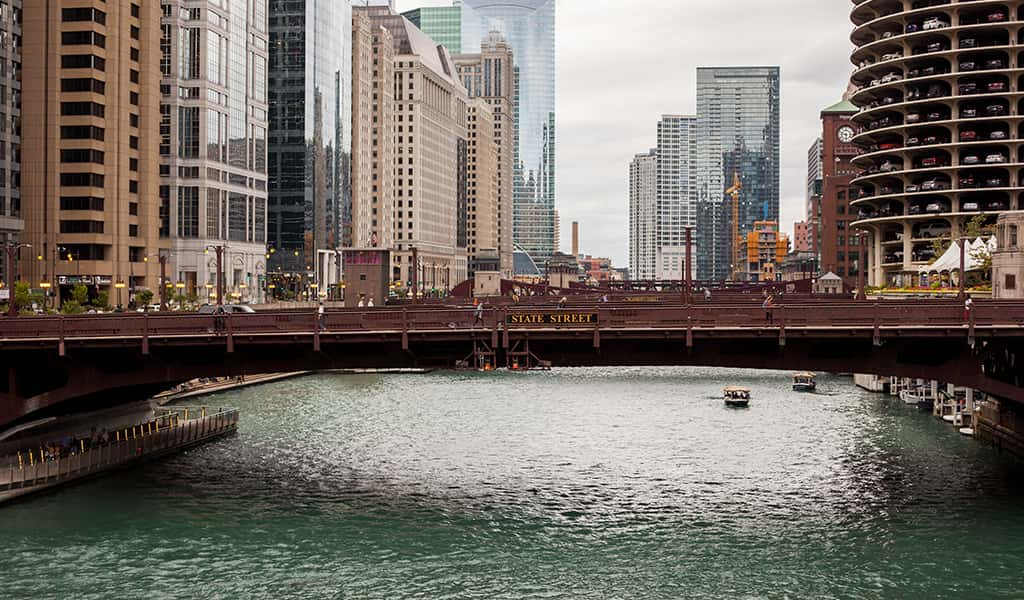
Pick up a Chicago CITYPASS
First, get yourself a CityPASS, which gets you a 51% discount on VIP admission to some of the most iconic attractions in the city and lets you skip ticket lines. At the time we checked in January 2019, adult passes (ages 12+) were $147.73 CDN and child passes (ages 3 to 11) were $124.04 CDN. It’s valid for nine consecutive days starting with the first day you use it. The CityPASS will get you into:
- Shedd Aquarium – Priority Entry
- Skydeck Chicago – Fast Pass
- Field Museum – VIP Entry
- Adler Planetarium – VIP Entry OR Art Institute of Chicago – Fast Pass
- Museum of Science and Industry OR 360 Chicago Observation Deck – Express Entry
- Hop on a Chicago Architecture Foundation Boat Tour
Though you can walk through downtown and get a glimpse of Chicago’s many stunning skyscrapers from the sidewalk, you can’t see them in their entirety. According to TravelingMom, the 90-minute Chicago Architectural Foundation’s River Cruise is “a beautiful slow boat ride through downtown Chicago, past the city’s iconic buildings.”
This isn’t a tour where someone drones on and on in terms you can’t understand. Instead, expect to learn how the city’s architecture interweaves with history, politics, business and art. Bonus: The eye-popping photos you’ll post on Instagram!
Some of the iconic buildings on the list include:
- Marina Towers (which has appeared in dozens of movies)
- The 110-story Willis Tower, one of the tallest buildings in the world
- The massive former Chicago Post Office
- The rounded residential units of River City
From gothic to contemporary, art deco, mid-century modern and more, you’ll see it all here. TravelingMom documented their experience and has some compelling reasons to spend the $46 for a daytime cruise or $49 for a twilight cruise at 7:30 p.m. Note: Purchase your tickets in advance to avoid disappointment.
Explore Navy Pier
Another iconic spot you don’t want to miss, Navy Pier is just over 100 years old and offers 50 acres of unforgettable attractions, experiences and cultural wonders.
In fact, travel blogger Nomadic Matt described it as “a carnival in the city”, with a huge Ferris Wheel, rides and games, theatres, a children’s museum, shopping, restaurants, and more.
Note: There is no admission fee to enter the pier itself, but individual attractions may have admission prices. The pier is closed on Thanksgiving and Christmas.
Stroll or bike along the Chicago lakefront
Need some fresh air? Rent a bike (or just walk) and explore the Chicago Lakefront Trail. See the popular Montrose Beach, the scenic Belmont Harbor in the Lincoln Park neighbourhood, Lincoln Park Zoo, Millenium Park (which isn’t directly on the trail but close enough that you can lock up your bike and take a detour), and the Museum of Science and Industry.
Splinster has a definitive guide to cycling the Chicago Lakefront Trail you’ll want to check before heading out.
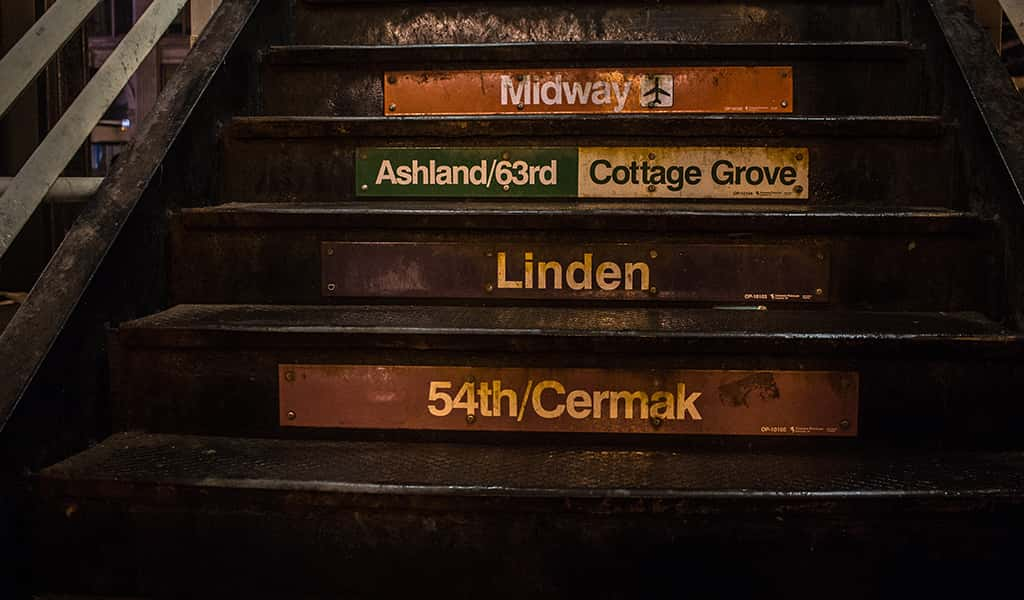
Check out the live theatre scene
The Chicago Theatre is a historic attraction the city is known for. When you first walk up to this iconic national landmark, you’ll probably immediately recognize its six-storey high marquee, which shows up almost any time the city is mentioned.
Built in 1921 and located in downtown Chicago, the French Baroque style theatre features a five-storey lobby. It was the first lavish movie palace in America. As Choose Chicago notes, “comedy legends, rock world tours, acoustic sets and more are all at home in this incredible venue. If you want to see C-H-I-C-A-G-O, this is the place.”
Shop Michigan Avenue’s Magnificent Mile
If you love to shop, Chicago is for you. Techies, fashionistas and bargain hunters will be in heaven in Chicago’s shopping district, which includes The Magnificent Mile. Here you’ll find everything from Chanel to Giorgio Armani, Bloomingdale’s, TJMaxx, Apple and more. There are also attractions, museums, theatres, the 360 Chicago Observatory, comedy clubs, a diverse list of restaurants – almost anything your heart could desire.
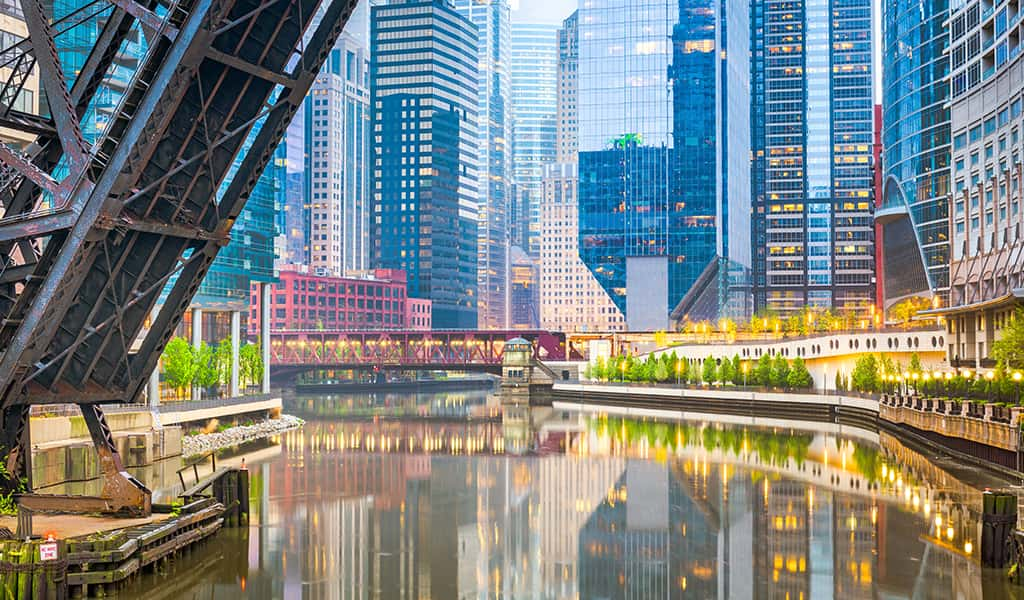
Take in a game at Wrigley Field
After you’ve shopped til you’ve (almost) dropped, take a load off and head to a Chicago Cubs game at Wrigley Field if you visit during baseball season, which runs from March to September.
From seeing the large, 1930s-era red marquee at the main entrance to grabbing some merch and seeing all the action from your seat, this is another activity to add to your list, even if you’re not a baseball fanatic. Ticket prices vary depending on section.
Travel and lifestyle blog Thyme & Love has an in-depth guide to Wrigleyville you should check out. Chicago is an eclectic city with lots to offer everyone from sports fans, foodies, fashionistas and shoppers, families, and kids of all ages. You can visit the city on a budget and with its world-class transportation system, free sights and attractions and lots of cheap eats on offer, there’s no shortage of things to keep everyone entertained while you’re here.
Are you travelling to Chicago for the first time? Returning to a favourite destination? What are your best tips when it comes to saving for vacations? We’d love to hear what you’ve planned, or any trips we missed! Share your story in the comments and tell us what destinations are on your wish list. Our team love saving for holidays and we hope to inspire our members with exciting suggestions to spend your Caddle money.
Trying Malaysian food, visas and advice on travel
Traveling Malaysia
Looking to jet off to an adventure lover’s paradise, with plenty of foodie destinations, sacred historic sites and villages to discover? You’ll want to put Malaysia on your must-visit list.
From the depths of Gua Mulu Cave on the island of Borneo and the Longhouse Villages to Sabah’s Mount Kinabalu, you’ll never run out of sites to see or immersive new experiences to enjoy.
The southeast Asian country, which is actually two separate, similarly sized regions located in the South China Sea, attracted just under 26 million tourists in 2017. Surrounded by Thailand to the north, Singapore to the South and Indonesia to the west, Malaysia is home to a multi-ethnic, multi-cultural population of 32 million people.
If you’re wondering how much you should save, and what to see and do on this trip of a lifetime, make yourself a bowl of wantan mee and dig in – we’ve put together some tips on our personal experiences visiting this lively, colourful destination.

When to go
Weather will be an important factor when you make the trip. Don’t want to get wet? Avoid the east coast during the monsoon season (which starts in November and lasts through March) as this is where the rain will fall, notes The Broke Backpacker. If you’re up for it, you’ll be rewarded with feasting your eyes on a lush green landscape, gushing waterfalls and thinner crowds at major attractions.
Luckily for you, Malaysia offers a few choices of when to visit depending on what you’d like to see and do. While you’ll get the best weather from March through October, you’ll see a number of festivals – like Thaipusam (one of the most important Tamil festivals in Malaysia), the grand cultural celebration of the Chinese New Year, Rainforest World Music Festival, and Eid, a joyful festival that marks the end of Ramadan – happening in January through February and May through July.
Speaking of Ramadan, if you’re keen to travel during the Islamic holy month (usually around May or June), expect to be warmly welcomed by locals and watch smaller cities and villages come to life at night:
“The holy month also sees Ramadan bazaars (special food markets) pop up in most towns and neighbourhoods every evening, offering an array of traditional Malaysian delicacies you may struggle to find at other times of the year (such as laksa Johor, a family-style laksa rarely sold in restaurants). Hotels, too, often put on elaborate Ramadan buffets during the holy month.” – The Journal, Intrepid Travel
You’ll want to plan for logistical challenges by checking transportation schedules, being aware of which areas may be busy and keeping in mind that business hours often change to accommodate this important religious observance.
Currency and travel costs in Malaysia
Malaysia uses the Ringgit for its currency. Affordability is another reason travellers love visiting Malaysia. According to travel budgeting website Budget Your Trip, you can travel in Malaysia for an average daily price of RM315 ($75). The average price of food for one day is RM71 ($17). One couple can find hotel accommodations for RM339 ($81). Of course, when it comes to knowing how much money to take, hearing about a diverse range of experiences can help. See more budget breakdowns on Phenomenal Globe, Nomadic Matt and Lonely Planet.

Know Malaysian customs
“Malaysia is a very religious country in my experience and it’s important to plan for this when packing clothes,” advised Helen Duffy, who visited Kuala Lumpur and Penang Island’s Georgetown in 2016. “For women, it’s customary to cover your shoulders and (everything down) to your knees.”
Tip: “While you’re exploring local destinations and meeting people around town, follow Malaysian customs. Men greet men with a handshake, while women greet men with a nod. Greet women with a slight bow.” – Traveling Malaysia
Important notes on air travel
The South China Sea divides Malaysia into two distinct masses. Peninsula Malaysia is located between Thailand to the north and Singapore to the South. It’s more populated and offers more transportation offices than East Malaysia, which shares the enormous Borneo island with tiny Brunei and part of Indonesia, according to SmarterTravel.
You might want to follow Claire’s Footsteps’ recommendation to search for AirAsia’s cheapest dates to fly. Booking directly with them may be significantly cheaper than using Skyscanner. (Editor’s note: She lists her travel, accommodation and other costs during her one-week visit to Malaysia in her post – worth checking out.)
Most flights to Malaysia arrive in Kuala Lumpur, which is served by Kuala Lumpur International Airport (KLIA, the city’s main international hub) and Skypark Subang Airport. From KLIA, you can take a taxi (SmarterTravel recommends using the coupon system) light rail or ride the Airport Coach for about an hour. From Subang Airport, your options are a taxi or direct RapidKL bus to KL Sentral.
Malaysia also hosts more than 30 commercial domestic airports.
Tip: Always check passport and visa requirements for the country you plan to visit. If you’re from Canada or the United States,, you must have a passport that’s valid for six months beyond the period of your stay. Tourist visas are not required for stays of up to 90 days. Canadians: Did you know you can travel to 172 countries without a visa. Americans travel to 166 countries without one.

Book shared accommodation and explore the street food scene
You’ll find a variety of accommodation options in Malaysia, from dorms to brand-name hotels, Airbnbs and more. As Nomadic Matt notes in his Malaysia Travel Guide, you can stay in a dorm for $25 to $50 MYR per night, depending on whether you’re staying in a large city. Airbnbs are spread across the country. Shared accommodation starts for an affordable 50 MYR per night. If you prefer privacy, you can have an entire home or apartment to yourself for 250 MYR per night. .
Staying on the island of Penang? Travel blogger Ashley Abroad recommends Roomates Penang, which bills itself as the “coziest guesthouse in Penang” for its “central location, glacial AC, historic Chinese shophouse facade and reasonable price.”
After a good night’s sleep, it’s time to explore the island. Adventurous travel bloggers On the Way to TV recommend taking in Georgetown’s famous street art, the bustling shopping district and gorgeous architectural landmarks including Fort Cornwallis City Hall and Penang State Museum. For food, swing by Kapitan, a restaurant in Little India where you can indulge your taste buds with a delectable feast.
Penang is known as one of the world’s best gastronomic destinations. Matador Network suggests hunting down a delicious meal of Char Koey Teow before renting a bike to see the some of the area’s famous murals.
Helen found Kuala Lumpur to be a “vibrant, exciting city with an amazing food culture,” adding the food she found on her street food tour was “affordable and delicious.”
Malaysia is the perfect spot to discover a new international culinary favorite. Its capital city Kuala Lumpur hosts five hot spots, including Jalan Alor – a perfect place to start your foray into the country’s authentic street-food scene, and Hutong Lot 10, described by The Culture Trip as “a maze of food wonders featuring some of the country’s beloved heritage dishes”, from Ho Weng Kee’s wantan mee to Soong Kee’s beef noodles.
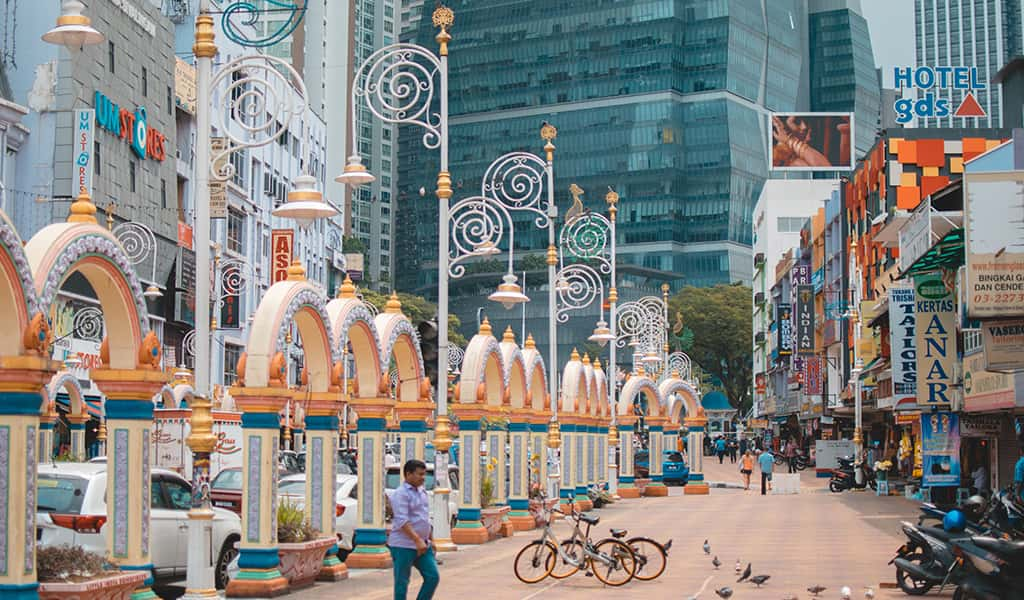
Discover Malaysian culture via public transport, train or taxi
Next, you’ll probably want to see some of Malaysia’s most popular attractions. Look to Jalan Lembah Perdana in Kuala Lumpur, where you’ll find something to fascinate you whether you’re passionate about spirituality, history, law and order or nature. The Islamic Arts Museum, National Mosque, KL Butterfly Park, Orchid Hibiscus Gardens, Royal Malaysian Police Museum, National Planetarium and more are all within a short distance of one another.
To get there, the Islamic Arts Museum advises taking advantage of Kuala Lumpur’s mass public transit system by opting for the RapidKL bus (B101 and B112) and get off at the Dayabumi Complex. From the complex, walk toward the National Mosque. You can also grab a convenient taxi, Uber, or use the popular Grab app.

An adventure lover’s paradise
Adventurous souls will find their paradise in Malaysia. Whether you relish the opportunity to discover mountainous peaks, explore the depths of mysterious caves or even try some BASE jumping, you’ll have endless chances to indulge your craving for an adrenaline rush.
Matador Network suggests hiking to the top of Mount Kinabalu (the tallest peak in Borneo’s Crocker Range), exploring Gua Mulu Cave (a UNESCO World Heritage Site situated in Gunung Mulu National Park), and checking out KL Tower International Jump Malaysia, a four-day base jumping event that welcomes about 100 base jumpers from more than 20 countries to Kuala Lumpur Tower annually in September or October. These are just a few of the 16 Malaysian travel experiences Matador Network recommends taking before you die.
Malaysia’s diverse food culture, lively attractions, welcoming atmosphere and deep connection to Asian history and spirituality will make your trip an unforgettable one, even if you’re traveling on a budget.
Don’t forget to tell us about your experience! Have you ever traveled to Malaysia, or are you planning to book a trip? What are your best tips when it comes to saving for vacations? We’d love to hear what you’ve planned, or any tips we’ve missed. Share your story in the comments and tell us what destinations are on your wish list. Our team love saving for holidays and we hope to inspire our members with exciting suggestions to spend your Caddle money.

Learn more about traveling in Malaysia
KL Layover Guide: Essential Info, plus 9 alternative things to do on a layover in Kuala Lumpur, Malaysia – Wander-Lush
Malaysia Travel Tips – Adventure in You
Travel Tips for Malaysia – Geographia
Survival Guide: Top 10 tips for travelling to Malaysia – Culture Trip
15 fun facts about Malaysia that will get you all excited – ExpatGo
Staying at a Longhouse in Borneo, Malaysia – Experiencing Indigenous Sarawak – Borders of Adventure
The best things to do in the Netherlands
When you picture The Netherlands, a few images probably come to mind: Windmills. Brilliantly colourful tulips, and shops that beckon to be explored. But this European country has so much more: Beautiful canals, historical architecture and museums that cater to every interest. Not to mention the food – everything from stroop wafels to delicious Gouda cheese.
With so many uniquely wonderful experiences to enjoy, it’s no wonder tourism in The Netherlands is growing and expected to soar over the next decade. According to The Netherlands Board of Tourism and Conventions, 18 million tourists from abroad visited the country in 2017. By 2030, that number is expected to hit 29 million.
If you’re looking to travel to The Netherlands on a budget, we’ve got good news – we’ve put together some tips based on our personal experiences and research of the best travel bloggers who’ve covered one of the hottest destinations in Europe.
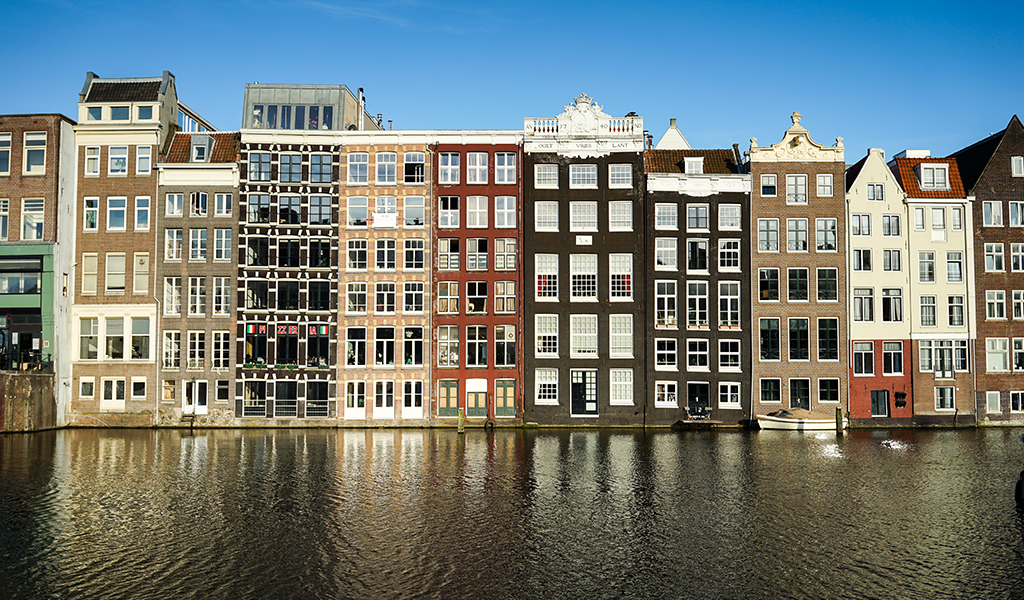
Geography
If you’ve never been to Holland or The Netherlands, the first thing you must know is that you’ll often hear these two terms used interchangeably. However, they’re actually different.
Holland is in The Netherlands and is actually divided into two provinces- North Holland and South Holland. Adding to the intrigue (and confusion) of this historic locale is that while Holland is a part of The Netherlands, it’s also used as a synonym for The Netherlands. The country is home to a breathtakingly beautiful landscape of colourful tulip fields, winding cycling routes, world famous canals and of course, the iconic windmills. Its transportation system is one of the best in the world.
Go for a bike ride through Rotterdam
The Netherlands is most vibrant and bustling throughout the spring and summer. The high season stretches from June to August. If you’ve got your heart set on a bike ride through the picturesque city of Rotterdam or spending the morning relaxing with your newspaper at a café terrace, this is the time to go as you’ll enjoy balmy temps.
Bonus: Everything is open. Keep in mind the famous museums will be packed with crowds and you’ll pay peak prices, so Lonely Planet says you should book ahead
During the “shoulder season” (April & May, September & October), you’ll find most sights open and the fewest crowds. Plus, prices are moderate and you’ll only need to book popular places in Amsterdam if you’re planning on sightseeing, says Lonely Planet. However, weather can be wet and cold. Bring warm clothes for outdoor cafés.
In contrast, you’ll find many sights outside the major cities close during the low season of November to March, and weather can be chilly and snowy (cyclists beware), but deals abound.
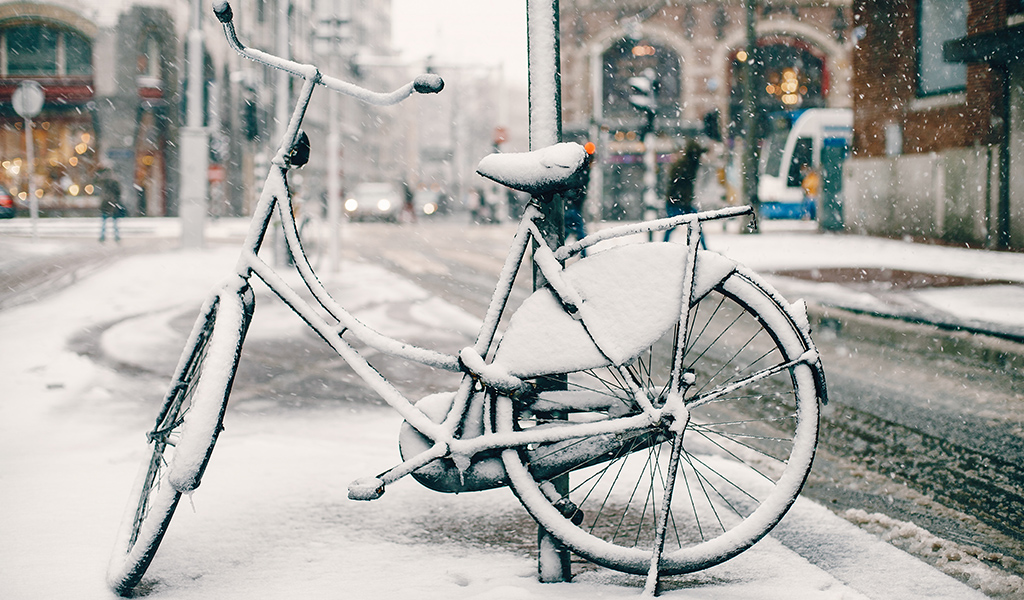
Stick to Airbnbs, hostels and budget hotels to save on accommodations
Costs for accommodation vary wildly depending on where you want to stay. Here’s what Nomadic Matt says you should budget for different types of Airbnbs, hostels or budget hotels. If you’re hoping to stay in Amsterdam, expect to pay more for each of these options:
Airbnb
Average about 15 euros (€) per night for a shared room; €50 to €60 euros per night for entire homes, including studio apartments.
Hostels
Typically €15 to €30 per night per dorm room (If you’re looking for a private room, make that €60 to €80 per night per two-person room, and add €20 to that in Amsterdam).
Suggestion: The Flying Pig Downtown, St. Christopher’s at the Winston and The Meeting Point, all in Amsterdam.
Budget hotel
€50 to €60 per night for a private bathroom and wi-fi. If you go the hotel route, The Brave Dame has a list of budget-friendly hotels, including:
- Marnix Hotel (Amsterdam)
- Kingkool The Hague City Hostel (The Hague)
- Budget Hotel (Leiden)
- Hostel ROOM (Rotterdam)
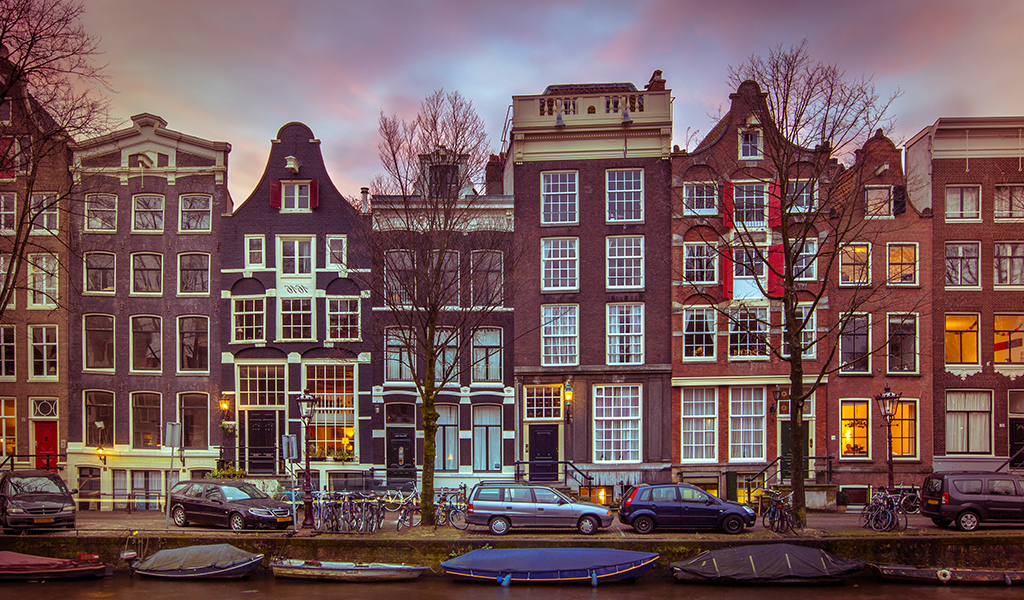
Visa information
The Netherlands is a Schengen area country (Canadian citizens do not need a visa to travel within the Schengen area, but visa-free travel only applies to stays of up to 90 days in any 180-day period. Entry requirements vary depending on the type of passport you use for travel. Find out more about short stay visas and travelling between Canada & the Netherlands at Netherlandsandyou.nl.
Hop on a train, take the metro or rent a bicycle
Thanks to its highly populated cities and modern infrastructure, the Netherlands boasts one of the best, most reliable public transportation systems in the world, and the country has one of the most dense road networks. After touching down at one of the major airports, many look to the rail network to get around and even cycle between destinations.
Airports
Flying into The Netherlands, you’re likely to land in one of the country’s top five civilian airports:
- Amsterdam Airport Schiphol
- Eindhoven Airport
- Rotterdam The Hague Airport
- Maastricht Aachen Airport
- Groningen Airport Eelde
While it’s the most convenient airport to Amsterdam, Amsterdam Airport Schiphol is also less affordable choice, as some of the major low-cost carriers operate out of smaller airports. See TripSavvy’s list of Netherlands airports for details, pros and cons.
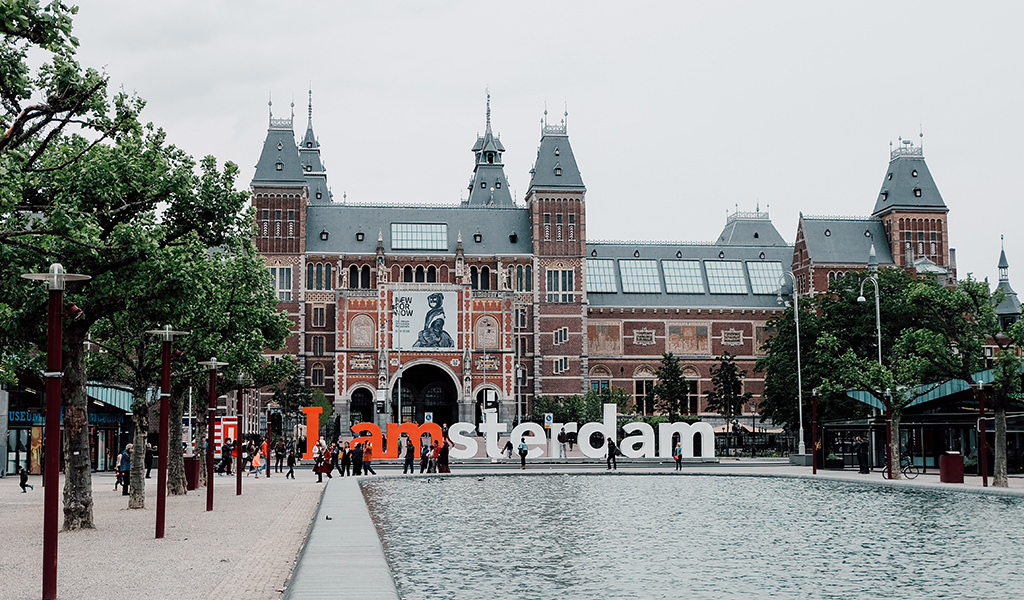
Pick up an OV Chipcard
You’ll want to buy an OV Chipcard (Chipkaart), which is like a fast pass or e-card you swipe as you board and leave to pay your fares on a bus, train or metro. You can get a personal OV Chipcard by applying and providing a photo. There’s also an anonymous one, which can be purchased at machines throughout the rail system. Top up your anonymous card (7,50) with €20.
Tips: Always keep your OV Chipkaart topped up. If you don’t have enough to pay for a fare, you could be fined triple the cost. – Netherlands Tourism
Take a train
Buy a day train card
Day train cards (dagkaart) are on sale at supermarkets and local shops, often for €15. If you have an OV Chipcard, you can also get an Advantage card (Dal Voordeel) for €50. Also check discount sites like spoordeelwinkel,, recommends DutchReview, which published a great guide to getting a cheap Dutch train ticket .
The national rail company NS (Nederlandse Spoorwegen) operates most of the trains in the Netherlands and you have a few different options when it comes to taking one, including:
Sprinter trains
These trains travel in short spurts, stopping at regular intervals in small towns (as well as the big stations) in between. If you need to get to a small town, this is your best option. But beware: Travel blogger Adventure Ellen says Sprinters chug along slowly. Plus, there are no bathrooms or wi-fi, and conductors always check tickets.
Her tip: Always wait the extra 10 minutes for the intercity.
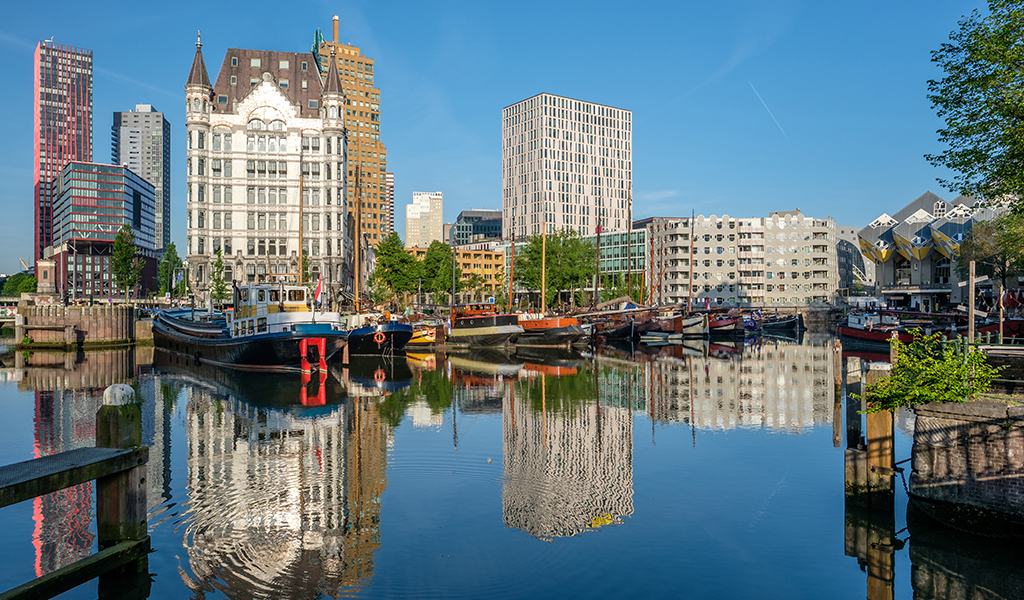
Intercity trains
If you’re traveling from one city to another, intercity trains are your best and quickest option, says Amsterdam Tips. In contrast to the Sprinter, Intercity trains are faster and make limited stops between major cities. Many of these trains offer free onboard wi-fi and have live travel information screens.
There are distinctions between double-deckers (VIRM – Verlengd InterRegio Materieel), single-deckers (ICM – Intercitymaterieel), and Intercity Direct. Amsterdam Tips has a comprehensive guide to trains.
Other options for public transit
There are so many options for public transit in The Netherlands that we can’t explain them all in detail here. In a nutshell, in addition to trains you can also catch a tram or take the bus. Amsterdam and Rotterdam have underground metros, while other cities offer over-ground metros (both of which get packed in peak hours). There’s also the popular ferry/boat service.
Another option: Rent a bicycle. The Netherlands is a cyclist’s dream as bike lanes are generally separated from car traffic. Learn more from DutchReview’s in-depth guide to public transport in The Netherlands.
Just don’t take a taxi or Uber, which are both expensive, says solo travel blogger The Brave Dame.
Tip: Whether you’re driving or on foot, pay attention to cyclists and when crossing bike paths. While on foot, make sure you’re not inadvertently walking on a bike path. These commonly run alongside sidewalks and are not always clearly marked. – Government of Canada

Check out street vendors, snack bars and food markets
A couple of the travel blogs we checked say to keep your expectations for Dutch food low, but that there are a few things worth munching on – you just have to know where to find them. The Brave Dame says to check street vendors or snack bars for patat (thick cut French fries), poffertjes (tiny, fluffy pancakes) or a delicious stroopwafel (syrup waffle).
Try a meal at any inexpensive chain restaurant, such as:
- Febo (fries and snacks)
- Wok to Walk (Noodles and other stir-fried stuff)
- Julia’s (Pasta)
You can also skip the chain restaurant route and visit Rotterdam’s food markets, as recommended by The Wanderlost Way. Markthal is a huge open marketplace with foods from all over the world.
There’s Gouda cheese, herring, Dutch apple pie (the quintessential Dutch dessert), and more delicious Dutch food to be found in Amsterdam.
Culture Trip has even more tasty delights you should keep an eye out for.
Tip: Offering criticism is more common than offering praise. Try not to take offense as the Dutch speak directly.

What to do
Stroll the tulip fields near Keukenhof
If you’re visiting between late March and early May (especially in April), you get a special treat – the opportunity to see iconic Dutch tulips in bloom! Although you can shell out €30 to see the fields at Keukenhof (the world’s largest flower park, travel blog WanderlustingK has some tips on how to explore them for free:
If you’re traveling with family or are on a budget, taking a train to Schiphol Airport then grabbing a one-way ticket to Keukenhof by bus (the 858, for €6 ) is the easiest route. Once you get off at Keukenhof, you’ll have about a 5 kilometre, half-hour walk to Hillegom to see the best fields.
Tip: The weather changes unpredictably, so bring a raincoat on your excursion. – WanderlustingK
See the sites in Amsterdam
Amsterdam is one of The Netherlands’ two capitals (the other is The Hague) and has everything you could want in a charming European city – breathtakingly beautiful canals, historical architecture filled with character, more museums than you could ever visit, vintage shops, and much more.
“Amsterdam has so many great places to visit,” says Helen. “I preferred the Rembrandt museum to the Van Gogh museum. Anne Frank’s house is so interesting but it books up well in advance. You can book a canal tour at night and have dinner on a boat,” she added, adding she found it easy to hop on a tram, and English was widely spoken. “I also loved the wax museum.”
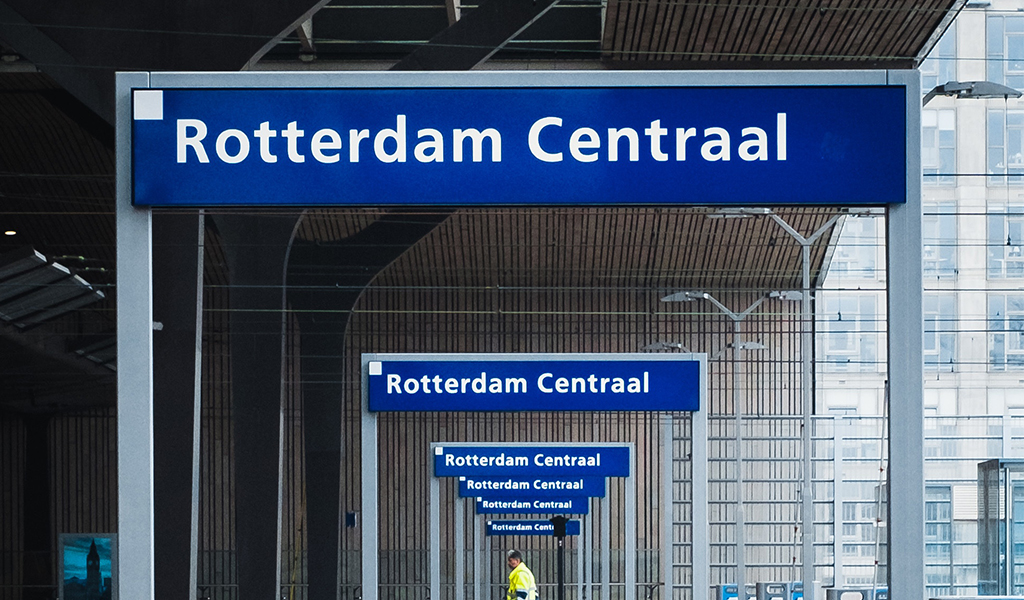
Explore museums
If you’ve got an interest or hobby, there’s probably a museum in Amsterdam dedicated to it. Whether you want to learn about chess, funerals, Heineken, houseboats or even the history of sex, there’s probably at least one of 75 to capture your attention, from the Rembrandt House Museum to Body Worlds , Amsterdam Heineken Experience and, of course, the sobering Anne Frank House , a hidden annex of an Amsterdam canal house where the iconic Jewish girl wrote her diary before being discovered and deported to a German concentration camp. This one is often sold out months in advance, but you can attend a two-hour guided tour of the South Amsterdam neighbourhood where she grew up.
Tip: Visit the tourist shops to get tickets in advance for all the tours and save time in lines for all museums. – Helen
Take a canal tour
If you have an evening free, why not take a stroll along the UNESCO-listed Canal Ring? This world heritage site is actually three canals that form a shape around the old city centre and is recommended by On the Luce as one of the best free things to do in the city, along with some lovely parks.
Visit the red light district for some taboo fun
Europeans are well-known for their liberal attitudes towards sex, and you’ll see that during your journey throughout Amsterdam, from its red light district (which is actually one of the safest parts of the city to its sex museums, such as Sex Museum – The temple of Venus and the Erotic Museum, an old warehouse in the middle of the red light district.

Take a day trip to Utrecht
Discover Domkerk’s cathedral in Utrecht
Just a half hour’s train ride from Amsterdam, Utrecht is a great day trip destination and one of the oldest cities in the country. Bonus: A lot of the attractions are free and the city is walkable.
The Domkerk is a mammoth church cathedral and a landmark at the heart of Utrecht. Its Gothic architecture serves as the backdrop to a beautiful courtyard. If you’re up for it, pay €9 to climb the 465 steps to the top of the tower.
If you’re a foodie, rejoice – there are tons of spots in Utrecht to have lunch or a snack , from cheap options to trendy cafes, suggests Olive Magazine.
Discover Rotterdam
Rotterdam is a famous port city that’s now a hub for modern architecture and the arts. There’s lots to see on a budget. Room Rotterdam recommends renting a bike for cheap or taking a guided walking tour to explore the waterfront, see amazing architecture and spot some of the best bars in town.
If you’d love to see some iconic Dutch windmills, head to the UNESCO village of Kinderkijk, where you can find 19 of them on the waterways.
You can explore The Netherlands on a modest budget and get almost anywhere you need to go on public transit – if you plan ahead, know where to look for deals and discounts, and stick to local haunts for deliciously cheap eats. You can even see unforgettable sites like the famous tulip fields, iconic windmills and charming canals on day trips to different cities.
Are you travelling to The Netherlands for the first time? Returning to a favourite destination? What are your best tips when it comes to saving for vacations? We’d love to hear what you’ve planned, or any trips we missed! Share your story in the comments and tell us what destinations are on your wish list. Our team love saving for holidays and we hope to inspire our members with exciting suggestions to spend your Caddle money.
Download Caddle
Download the Caddle App11 of the best savings accounts Canada
The world of personal finance can feel overwhelming when you dive in – how do you know where to invest, which debts to pay off first or what you should do with your savings when everything feels so new? Fortunately, you can learn a lot – for free – by researching reputable sources online. Here are 10 Canadian personal finance and savings bloggers who know their stuff.
Half Banked
Desirae Odjick’s mission is to help millennials use their money to live the life they want. She demystifies all things money, from saving to spending, investing and even offering great advice on money management tools. Follow Desirae and soon you’ll be managing your money like a pro (even if you’re not one).
Must reads: How to avoid spending your savings and Manage your money like a pro – even if you’re “not” one.

Boomer & Echo
Robb Engen, a 38-year-old married father, founded the award-winning Boomer & Echo as his online side business. He also holds a full-time job and is a self-taught money expert who hopes to become financially independent by age 45. He uses this blog as a guidepost to keep himself accountable and also shares debt reduction strategies, budgeting basics, short-term savings goals, investing, retirement prep and more.
Must reads: 35 ways to save money and What are you doing with that tax refund?
How to Save Money
This list wouldn’t be complete without a blog actually named How to Save Money. Self-described money nerd and techie by trade Stephen Weyman targets his content to Canadians looking for ways to save money on the mundane costs of life so they can spend guilt-free on the things that matter most to them. His well-researched and detailed articles help you spend less and get more.
Must reads: Eating out at restaurants: The ultimate guide to spending less and The smart commute: How to make the most of your time and money.
Common Cents Mom
Mom Hollie Pollard’s mission is to share her journey of becoming a smart consumer who knows that cents matter. You’ll want to subscribe if you’re looking for common sense money tips, life hacks, smart shopping solutions and the joys of giving back. Her blog is one of the top 20 blogs in the GTA written by one person according to Alexa, and has been listed as one of the top 30 personal finance blogs in Canada.
Must reads: How to plan a staycation and How to make a profit at thrift store shopping.
Young and Thrifty
This leading personal finance website for millennials in Canada is a one-stop shop for financial tips and advice. It’s managed by Kyle Prevost and Justin Bouchard, two Canadian millennial money experts, entrepreneurs, and investors seeking to raise financial literacy among their peers. They tackle everything from easy budgeting to how to save money and credit card reviews. The site is one of the most popular personal finance websites in Canada and has been featured in several major media outlets.
Must reads: How to save money on your wedding and How to get more money back from your tax return.
Financial Uproar
Financial expert Nelson Smith has one goal: to educate the masses on personal finance while making them laugh. As someone who became financially independent by age 35 and achieving seven-figure net worth, he has spent thousands of hours studying personal finance, investing, and a plethora of other financial topics. His writing has been featured on several major media sites.
Must reads: Am I oversaving for retirement? and The power of ‘good enough’ financial planning.
Fabulously Broke in the City
Fabulously Broke in the City is written by a 20-something who got out of $60,000 of debt in 18 months, earning $65,000 (gross) annually. She’s “just a girl trying to find a balance between being shopaholic and a saver.”
Must reads: Easy ways to protect your personal finances from further economic contraction and From a financial perspective: 4 reasons why buying a new car is not the recommended route to take

Source: Instagram
Jessica Moorhouse
Jessica Moorhouse is a millennial money expert, speaker, award-winning blogger and more whose passion is personal finance and living a balanced lifestyle. She’s on a mission to teach others how to take control of their lives by taking control of their money.
Must reads: How to prepare financially if you want to become an entrepreneur and It’s not how much you earn that’ll make you happy (trust me)
Earth and Money
Earth and Money is written by a self-described late 20s, card-carrying member of Generation Y living in Toronto who blogs anonymously under the name Earth and Money (sometimes using EaM as a moniker). Passionate about personal finance and our environment, he began blogging to battle the misconception that living an environmentally responsible life costs more money.
Must reads: A quick and simple guide to envelope budgeting and Saving on home insurance
Retire Happy
Retire Happy publishes top quality, timeless financial information by various contributors that can make a lifetime difference if you’re looking to plan practically and make retirement the best years of your life.
Must reads: What is stopping you from financial success? and Ten ideas to happy and successful retirement.

Source: Instagram
Money We Have
Barry Choi is a personal finance and travel expert whose blog is one of Canada’s most trusted sources on money and travel. He combines is knowledge of finance with his passion for travel and encourages people to see the world. He shares practical tips everyone should know regardless of your budget.
Must reads: 5 ways to save for your child’s education and My wife and I saved 50% down payment and still travelled the world.
How to start with freelance jobs
Freelancing is one of the best jobs you can have in 2018 for many reasons: remote work is on the rise, more businesses and entrepreneurs are hiring freelancers. Plus, the infrastructure of freelance communities is becoming stronger every day.
If you’re thinking of joining the ranks of freelancers, you’ll be in good company. Upwork’s 2018 Freelancing in America Survey says 56.7 million Americans freelanced this year. And more of those people are freelancing by choice (61%, up from 53% in 2014), not necessity.
Freelancers Union’s Freelancing in America 2017 study predicted freelancers will make up the majority of the U.S. workforce in just a decade.
But where do you start? We’ve got a few quick tips for you!

Create a basic business plan
Every successful startup or freelance business starts with a well-formed and executed idea. It doesn’t need to be a 100-page document that sits on a shelf and collects dust. For freelancers, creating a large business plan up front would be a waste of time since there are so many unknown factors. Instead, save that step for the growth/investment phase (if you reach that stage) and get yourself a copy of the Lean Canvas, which was adapted by Ash Maura from the popular Business Model Canvas by Alexander Osterwalder.
The Lean Canvas uses a nine-block concept to help you identify your business model and fill in the blanks about your product or service and how you’ll market it.
Pick a discipline and niche
Do you have an eye for the visual, or are you a word wrangler? Maybe you love crunching code and building beautiful websites. Whether your skills are in writing, design, development or something else, this is the time to master the basics and learn from diverse sources such as books, courses, articles, online tutorials and knowledgeable professionals in your community.
Next, decide whether to generalize or pick a niche. There are arguments for and against choosing a niche – many say you can target your message better and make more money when you have specialized skills. Know the benefits and risks and decide which is right for you.

Build a portfolio
Before they hire you, potential clients (rightfully) want to know you’ve got the experience and skills to get the job done. They also want to get a feel for your style and the work you’ve completed for previous clients. A portfolio allows you to showcase your work to clients you want to serve. It should be a living document, so naturally you’ll include as much as you can when you’re new to your field and pare down as you gain experience.
The projects you highlight don’t have to be paid. For example, are you a new graduate with school, co-op, internship, or volunteer projects under your belt? Include them. Switching fields or starting fresh? Create sample pieces (indicate them as such to maintain transparency). Writers can publish content on their own sites and on Medium, submit guest posts and write about events happening in their community; designers can build mockups and wireframes, and developers can include code they’re proud of.
Pro tip: Go beyond just linking to your project. Write a detailed description of the project and how your work helped the client. Include screenshots.
Skillcrush has some great tips for designers and developers on how to build an impressive portfolio site. If you’re a writer, check out freelance writer Courtney Hall Lee’s advice on how to create a portfolio with zero experience.
You don’t have to build your portfolio from scratch. If you’ve got a LinkedIn account (you’re on LinkedIn, right?), you can add projects to your profile. Platforms such as Contently and others exist to help freelancers showcase their work and match talent to companies. If you’ve got a website on WordPress or another Content Management System, your portfolio can live there (more about that below).

Create a website
Your website is your online home and is an absolute must-have for any freelancer, since you’ll rely on it to generate new leads. A well-designed website is fast, user-friendly, mobile responsive, secure, and optimized for search engines.
This is where knowing who your ideal customer is will come in handy, because every word on your site should be geared toward building a relationship with them and persuading them to reach out.
Take time to scope out sites of other freelancers in your industry to identify aspects you love (and ones you definitely hate). Doing this will help you form ideas of what to include on your own site. You’ll want to start with a few basic pages, including:
Home
Include your value proposition, a brief description of your services, and your contact info.
About
Here’s your chance to establish a personal connection with your visitors. The secret to a great about page that gets you noticed and wins clients is that it’s as much about them as it is you. Share your story, demonstrate your experience and express your passion, then tie it back to their pain points and problems. Include a call to action to book a call with you at the bottom.
Services
Which services do you offer, and how are you different from the competition? Focus on your ideal client, their pain points and problems, and how you solve them.
FAQ page
Do a quick survey of your target market. What are the most common questions your potential clients will have about your services and process? Create an FAQ document and post it to your site. Now you can send people a link (or copy and paste the answer), without needing to type out a reply each time.
Contact
The contact information you add here is your choice. Because some people prefer contact via traditional means, you may want to list your email address (Email: name (at) gmail (dot) com, and a phone number, along with your social accounts, mailing address and an email form asking for (a few) details about them and their project.)
Just like with your portfolio, you’ve got a variety of choices when it comes to where to build your website if you don’t want to hire a developer or write code. WordPress is a popular choice for freelancers (you can use a page builder plugin to streamline the process). There’s also Squarespace and Wix , and a few other platforms.
Related: How to choose the best website builder – WPBeginner
Pick one based on your needs, budget and current and future goals. You’ll also want to add your website to all aspects of your branding – social media channels, business cards, email signature, and anything client-facing – so people know where to find you.

Start with a few must-have tools
In your first year, you’ll need all the help you can get to run a lean, mean, productive and efficient practice. There are tools out there to help you do just that, from web-based project management and time-tracking software to lead management programs and social media automation apps.
Of course, one caveat is that you can sink so much time into trying different tools that you get bogged down in indecision and overwhelm. Don’t let that happen – choose a few that fit your needs and get to work. You can always change your toolset as you develop and hone your processes.
AND CO has compiled 600+ tools & resources for freelancers.
Find your ideal client
The deeper you get to know your customer, the better you can market to them. That’s why you need to develop a profile of your ideal client. Think of projects you’ve worked on (if you’re launching your freelance career, reflect on jobs, volunteer positions, co-ops, etc.) in the past and ask yourself these questions:
• What did you like about these experiences?
• What were the good, bad, and ugly parts?
• What about your bosses/clients themselves – what were their good qualities?
• Which industries were these people in?
An important step in defining your ideal client is to identify your boundaries and expectations. Decide which behaviour you absolutely won’t put up with as well – this could include:
• Verbal abuse
• Non-payment or chronically late payment
• Disrespecting you or your time
• Refusing to understand the difference between an employer-employee relationship and a business-freelancer relationship
• Anything else that will make them a “client from hell.”
Your definition of an ideal client will change over time. As you gain experience, you’ll naturally accumulate more data about who you work with best with, and which projects you gravitate to. In the meantime, designer Benek Lisefski and Freelancing Digest have published informative articles on this topic.

Sign up to freelancer sites
You should absolutely be networking locally, but there are also umpteen websites dedicated to matching freelancers, remote workers and independent contractors with clients. Sign up to mailing lists and create profiles on sites where you’re likely to find your ideal client. These can include:
• Upwork
• Fiverr
• FlexJobs
• LocalSolo
• Nodesk
• Remote.co
• We Work Remotely
Of course, this is a small sample of an ever-growing list of remote work and freelance sites. Forbes and Skillcrush have compiled extensive lists of frequently updated sites, both general and industry-specific.

Network, network, network
It’s great to create profiles on freelancer sites, but authentic, in-person relationships are the lifeblood of your freelance career. This is because while you’re one face among many in a sea of freelancers looking for work online, people remember personal connections.
ABN – Always Be Networking – is a popular acronym among freelancers for good reason. The good news is that, contrary to popular belief, networking isn’t all about you. Knowing that people mostly care about themselves and finding solutions for their own problems (not judging your ability to dazzle during conversation) may help take some of the pressure off of introducing yourself if you tend to feel anxious about meeting new people.
Here are some ideas for how to get started:
- Attend a meetup
- Join a professional organization
- Search for online groups and forums
- Volunteer your time with an industry-related organization
- Join a co-working space
Pro tip: Step up your networking game and apply to speak at an event. Organizers are always looking for speakers and it’s a great way to establish authority and credibility among potential customers.
Bonus tip: Spend your time networking with others in your industry as well as potential customers. Spread your time among groups in your industry as well as general business groups, and you’ll grow a diverse, thriving network.
For more networking tips, see Torquemag’s 6 tips on how to improve your freelance business through networking and Double Your Freelancing’s How freelancer’s can make the most of networking events.
You’ll have a lot on your to-do list once you decide to launch your freelancing career, but if you’re prepared to put in the work to plan, create a simple website, research and find clients, and network, you’ll soon be on your way to building a thriving practice.
Resources
Here are some more handy resources about freelancing:
Free
5 valuable online communities for freelancers – Mashable
11 facts to know about freelancing in 2018 – Tech.Co
The freelancer’s guide to finding a profitable niche – Freelance to Freedom Project
Paid
The Freelancer’s Bible: Everything you need to know to have the career of your dreams – on your terms.
Why I choose St. Catharines for Caddle
Why I chose St. Catharines
Four years ago, I had just quit my full-time marketing job to establish and launch Caddle. While we could have chosen Toronto or any of the cities within Hamilton or the GTA, we’ve never wavered from knowing that St. Catharines, Niagara is home.
Making the choice was easy because we want to see St. Catharines thrive. For myself and many of our management team, our decision was personal; we have roots in Niagara and want to be part of its success as it becomes a major contender in Canada’s digital economy.
Here are a few reasons I continue to choose St. Catharines:

Source: Wikimedia
1. Access to high-quality talent and lower startup costs
Four years in, I’m still often shocked by what’s here. If we can’t find the talent we need right in St. Catharines, it’s in Grimsby or another of Niagara’s municipalities. We chose Niagara as our home for the region’s lower cost of living, beautiful natural wonders, high quality of life, and arguably easier access to talent. The cost to launch is lower here, too – a huge plus when you’re a founder of a small startup looking to establish a home base. If we’d located in Toronto, we would have at least quadrupled our burn rate with the increase in costs.
In contrast, Niagara offers the best of both worlds – a growing region, it’s just far enough (about an hour and a half) away from hectic mid-Toronto traffic but close enough that we can jump on the QEW and zip up to the big city when we need to. Plus we now have the daily GO train going right into Union!
While Toronto’s talent pool may be 50 times larger than Niagara’s, there are 100 times more companies in Canada’s largest city competing for top employees. In terms of high-quality talent per capita, I feel we’re in a better position here.
Caddle is thriving and continues to grow. In Toronto, we’d have been one of a million promising startups. In St. Catharines, we’re a big fish in a small pond. We attract highly talented web developers, marketers, Customer Experience and IT staff, and more.
2. Exceptional quality of life and sense of community
Our employees love the short, easy commute as well – Brian Cline, our Head of Technology, lives in Niagara Falls and commuted to Etobicoke for years. Now, he has about a 20-minute drive to work.
Most of our staff live within a 15 to 20-minute drive, which means they can spend more time with their families and less time facing the gridlock of GTA traffic every day. I walk to work in about seven minutes and often bring my dog, Maya, in with me. We find that our staff love the community they live and work in. They’re also invested in our long-term success and are passionate about helping to build a positive, dynamic company culture.
From the first day, I’ve always stressed the importance of family, flexibility, and work-life balance. Because our employees tend to stick around, they enjoy a lot of trust and flexibility within our team, which makes for a happy, productive work environment.
If you’ve got an important appointment to attend or a can’t-miss recital for your kid, you can take time off and do that here in Niagara (which is essential – happy families mean happy people!) We always say that no matter where you are in the region, for the most part everything you’ll need – schools, food and entertainment, shopping, outdoor spaces like parks and hiking trails, the gym – is within a 30-minute drive. This all contributes to high employee satisfaction, low turnover rate and great work-life balance.
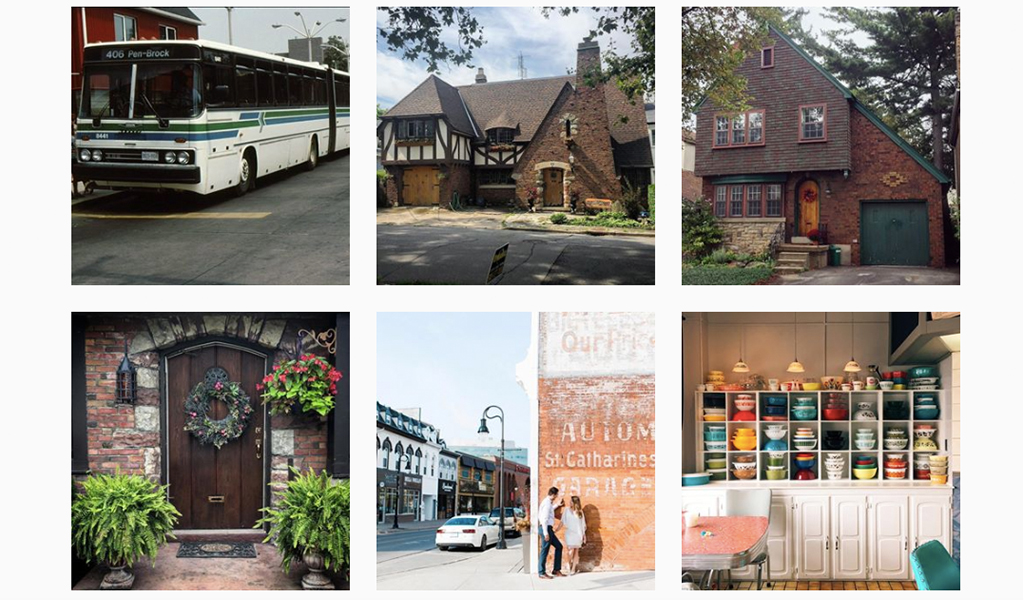
Source: Instagram
3. Government funding and support
While access to talent is a critical factor, so is funding and support. There are also unique opportunities for funding. For example, we’ve gained access to funds from federal and provincial levels of government looking to fund outside of the GTA.
As for local support, there’s Innovate Niagara, a business incubator and one-stop shop for the region’s entrepreneurs for intensive workshops, training and educational and networking events. The team there have been critical to our success, from walking us through incorporation to legal advice and hiring employees. They are one of many organizations, agencies, and companies playing a role in building our flourishing tech community.
When I knocked on their door, I had an idea, but I didn’t know how to turn it into an app. I didn’t know how to incorporate or where to find local talent. We’ve been with Innovate Niagara for more than two years, eventually joining their incubator at 1 St. Paul Street in downtown St. Catharines. We’re currently both located a few blocks from there, in the same building at 43 Church Street. Within our first three months, they’d connected me with legal resources, given me names of three local web developers, and introduced me to their executives in residence. They also provided access to mentorship, coaching, and funding for an early public relations campaign.

Source: Innovate Niagara
Wrapping up
Today, I love contributing my time to Niagara’s entrepreneurial community by speaking at events and participating on panels where I can promote Niagara.
Bonus: Doing this also helps me meet people working on amazing projects, and to develop as an entrepreneur. I’m still learning from our team, consumers, and the wider community every day, and don’t see that slowing down any time soon.
The future looks bright. We’re confident in the leadership at city hall and wholeheartedly believe in Mayor Walter Sendzik’s vision for the future. With the right programs, opportunities for incubation and the right incentives, St. Catharines (and Niagara as a whole) will be at the forefront of innovation. I look forward to the day when Caddle is just another of the many digital pioneers who saw Niagara’s potential in its early stages.
Demographics and loyalty in the workplace
Demographics and loyalty in the workplace
There are many reasons why living in Canada is so desirable: access to healthcare, education, our abundance of fresh water and beautiful nature – even employment. In fact, Canada continues to show a downward trend in unemployment year to year. Statistics Canada reports that in January 2018, Canada’s national unemployment rate was down to 5.9% from 6.8% in January 2017.

This positive trend in the workforce is not necessarily as beneficial for employers, however. Earlier this year, The Globe and Mail reported that 89% of Canadian employees are prepared to leave their current job for “the right offer,” up from 78% in 2014.
Analyzing employment trends, the Caddle team decided to ask Canadians if it’s okay to apply and interview for jobs, even if there is no intention of leaving a current position.
The majority of Millennials (29%) and Generation Z (31%) considered it completely acceptable to apply for other jobs, compared to the majority of Generation X (29%) considering it only somewhat acceptable, and Boomers (33%) considering this not at all acceptable.

When it comes to interviewing for a job you have no interest in taking, however, all four generations shared more similar views. The majority of Millennials (28%) and Generation Z (31%) considered this action only somewhat acceptable, while the majority of Generation X (30%) and Boomers (43%) considered this to be not at all acceptable.
There’s another split when it comes to gender as well – particularly around interviewing for a job despite being happily employed. The majority of men (28%) deemed this completely acceptable, while the majority of women (32%) deemed this not at all acceptable.
There are positives to applying and interviewing for jobs even if you’re happily employed: it’s valuable practice, an opportunity to expand your professional network and it’s a chance to get a better sense of where you stand compensation-wise. If you decide to apply or interview for another job, though, avoid letting it affect your day-to-day responsibilities, and always be careful not to burn bridges with either party.
How can employers stay competitive in a cash-driven culture?
Caddle Survey
In a recent survey of 10,000 Canadians, Caddle found that the majority of the workforce chose their current job for its better salary over their previous job (24% of Millennials and 23% of Generation X).
It appears that employers are recognizing this cash-driven culture and responding accordingly to attract new talent. In their 2018 Salary Guide, Export Development Canada (EDC) reports that 40% of employers are willing to break salary guidelines to recruit new hires, and offer 15% over expected salary to attract highly skilled professionals. EDC aptly points out that this approach is problematic, however, as the same 3,500 hiring managers EDC surveyed showed a continued trend toward offering less than 3% salary increases to existing employees. This results in a growing number of people willing to move jobs, up to 90% in 2018 from 75% in previous years.

With increasing expectations around salary and an aging population, how do Canadian employers stay competitive when hiring and attract top talent?
Human resources (HR) platform Pro Sky recommends focusing on developing a positive work environment, considering candidates with potential (i.e., over experience to date) and focusing on coaching and mentoring opportunities. Providing recognition and understanding work-life balance are other key assets.

HR consultant Sharlyn Lauby of HR Bartender suggests establishing a solid employee referral program, giving candidates a realistic job preview, and considering boomerangs (former employees who can return with fresh perspective and skills). Sharlyn also recommends focusing on the application and interview process, making it easy to apply and training hiring managers to interview well.

The BC Tech Association challenges employers to reduce response time and rounds of interviews, as top talent – especially in the tech industry – won’t necessarily stick through the whole process anymore.
Most importantly, EDC reminds employers to take care of the employees they already have before anything else.
